2024-02-03 to Vlissingen
Being in the last days of my working life, and therefore in the last days of my free travel railway card, I thought I'd better make good use of it while it lasts. I started out in the north east of the country. The south west was the next goal: I visited Vlissingen today.
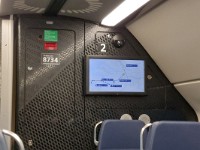 1 The journey to Vlissingen is simple: the local train to Dordrecht and then change trains to the Intercity that goes all the way to Vlissingen directly. The weather was pretty bleak and overcast and the windows of our VIRMm were very dirty so I had no opportunity to make any photos en route. |
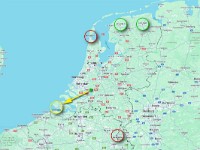 2 Nearing retirement I wanted to make use of my free business card once more before it ends and travel to the extremities of the Dutch Railways (NS) network. Having ticked off Leeuwarden and Groningen from the list I now set out towards Vlissingen, our Flushing as the British say, but I never figured out who or what they were trying to flush ;-). |
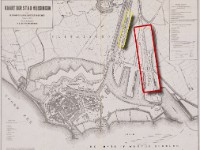 3 The railway to Vlissingen opened up a very remote and isolated part of the country in 1873. The original Vlissingen Stad (city, in yellow) was situated closer to the city. Vlissingen Haven (Harbour, in red) was intended for transfer of traffic to and from the ferries. Map of Vlissingen, 1875. Source: Zeeuws Archief, Zeeuws Genootschap, Zelandia Illustrata, Deel I, nr 1438. This map reveals how cumbersome this operation is. "Stad" is hardly any closer to the city than "Haven" and having two large termini so close together with no interconnection (other than going out on the main line again) is obviously a planning disaster. It is a ready explanation why Vlissingen Stad was closed after only 22 years. |
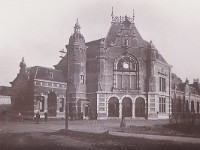 4 Vlissingen Stad was closed in 1894. Vlissingen Haven had become far more important due to the international ferry traffic and a new station building opened in 1892. |
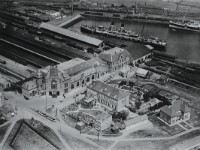 5 Vlissingen became an important link between London-Berlin-Moscow via the line of the NBDS and the rich an wealthy disembarked from the ferry in the harbour and changed over to continue their journey by train. And of course the station had to offer them a fitting welcome. (Photo 1920/1925. Source: Zeeuws Archief, Fotocollectie Vlissingen, nr 24597) Read more about the station Vlissingen. Read more about the NBDS (automatic translation) Photo Zeeuws Archief, no 25445 |
 6 From about 1890 to 1914 the connection via Vlissingen prospered. This era ended abruptly when WW1 broke out and international traffic to and from the British Isles all but ceased. After the end of hostilities, the traffic never recovered. The NBDS was integrated in the larger companies and finally amalgamated into the NS (Dutch Railways) in 1919. The NBDS line lost its international status and vanished into insignificance. This left Vlissingen with a far too large, if not to say pompous, train station at an extremely inconvenient location. |
 7 A curious accident happened in 1899 when a train failed to brake and ended up in the station restaurant and the went through the floor (Source: Zeeuws Archief, Fotocollectie Vlissingen, nr 7201) |
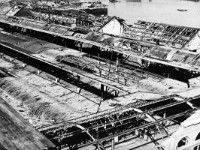 8 In WW2 Vlissingen was a hard fought for strategic location, both in 1940 when the Germans took the Netherlands as well as preceding the liberation in 1944. It left the 1892 station in ruins. In hindsight it might have been possible to save at least the main building, but the country had to be brought back to a working economy and the sheer size of that task left little room for such considerations. The building was razed to the ground. |
 9 After this small digression into the history of the station we return to our daytrip. Our double decker VIRMm ended here. |
 10 The platforms's canopy is supported by the columns of the 1892 canopy. |
 11 |
 12 In my mind's eye I could not help but seeing those wealthy and rich of old boarding their train into a future of a world that was soon to be crushed by two world wars |
 13 |
 14 This part of the current station retains the only part of the 1892 station. |
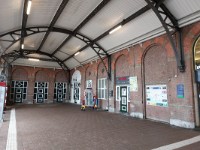 15 |
 16 |
 17 |
 18 The weather was drab and stormy so the photos are not really convincing |
 19 Our VIRMm is already announced for its return to Amsterdam |
 20 |
 21 A VIRMm mirrorring in the SNG's flanks |
 22 In between the SNG you can see rollable stairs to enter and leave the caraaige. They are meant for service staff. |
 23 A row of the old columns |
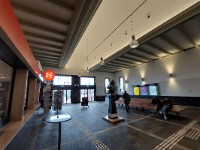 24 The station entrance hall. The current building dates from 1950. |
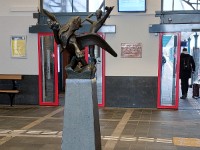 25 |
 26 |
 27 The 1950 building was a design by Sybold van Ravesteyn. Incomprehensibly it built at the very location of the old Vlissingen (Haven) station. |
 28 The statues on the front have the attributes of fishery ... |
 29 ... railways ... |
 30 ... and agriculture |
 31 |
 32 The coat of arms of the province of Zeeland (Zealand, yep Old Zealand that is) |
 33 |
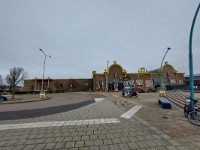 34 |
 35 A scultpture commorating the electrification of the railway in April 1957. Note: it was one of the last mainline to be electrified. Steam had already all but disappeared and actually ended in December the same year. |
 36 The mouth of the Westerschelde, the gateway to the harbour of Antwerp (Belgium) |
 37 |
 38 As this is a railway related album I will limit the photos of non-railway objects. Suffice to say that Vlissingen has a very attractive old city, well worth a daytrip. |
 39 By the time we returned to the station the weather had cleared a bit and the sun even tried to come out (but did not succeed). |
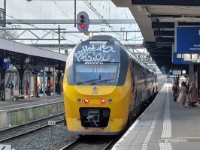 40 Another VIRMm took is back to Dordrecht |